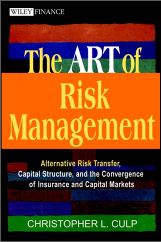Details

|
Culp, Christopher L.: The ART of Risk Management Alternative Risk Transfer, Capital Structure, and the Convergence of Insurance and Capital Markets Preis: € 73,90 Reihe: Wiley Finance Editions, Einband: Gb Auflage: 1. Auflage Verlag: John Wiley & Sons New York Erscheinungsdatum: 04/2002 Seiten: 592 S. ISBN-10: 0-471-12495-8 ISBN-13: 978-0-471-12495-5 
|
||||||
|
Weitere Fachbücher aus dem Fachgebiet: Finanz- u. Anlagewesen | Institutionelle Finanzplanung |
|
|||||||
| |||||||




 CRISPR-Cas:
CRISPR-Cas: Budding Yeast
Budding Yeast Learning and Memory
Learning and Memory Conservation Science: Balancing the Needs of People and Nature
Conservation Science: Balancing the Needs of People and Nature Introduction to Optical Microscopy
Introduction to Optical Microscopy Organic Chemistry
Organic Chemistry CURRENT PROTOCOLS Wiley USA
CURRENT PROTOCOLS Wiley USA